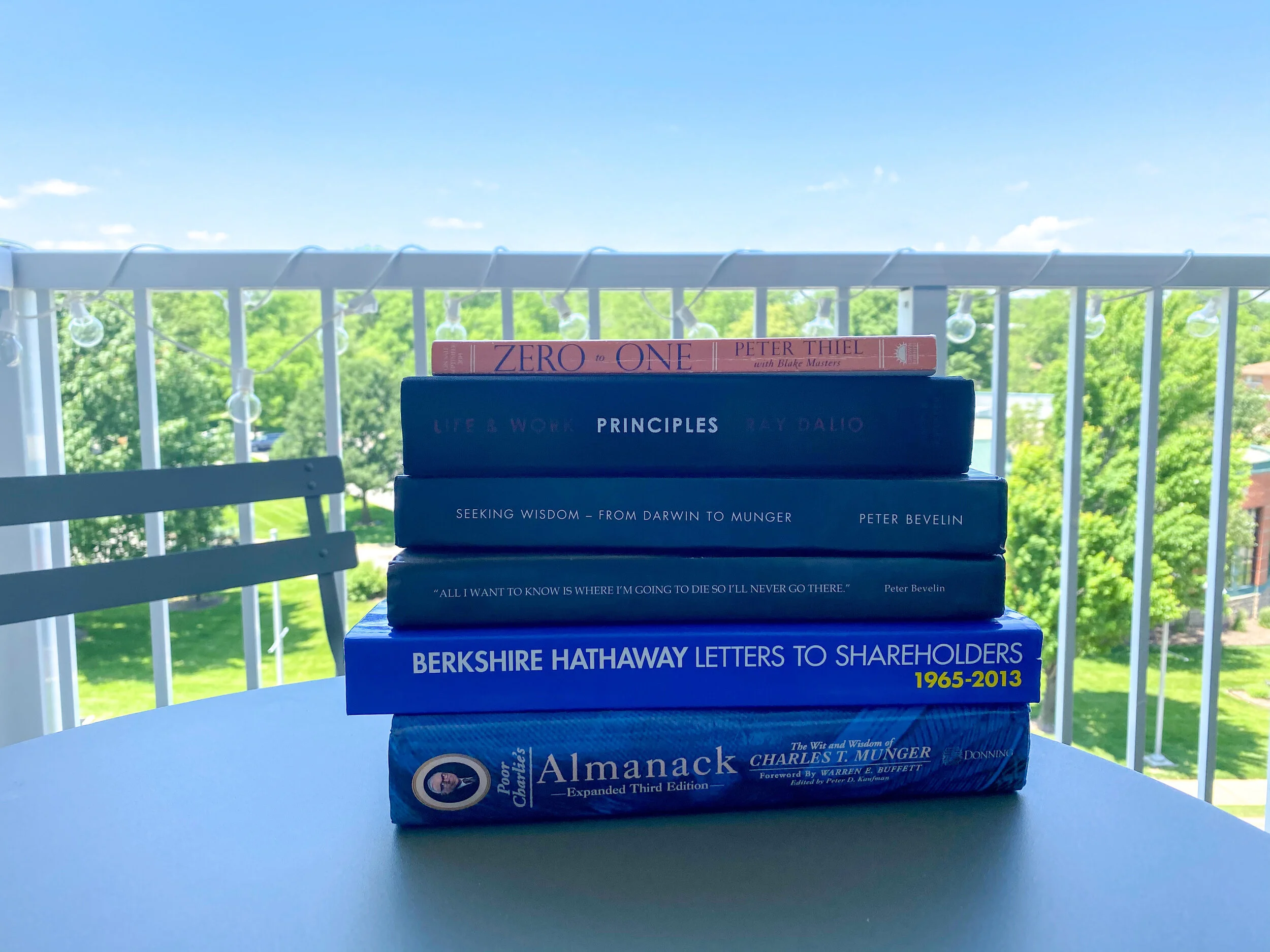6 Books that Inspired the Navalmanack
The most common question I hear is “How did you get the idea for the Navalmanack?” This is a question I can answer with a photo of 6 books and a short story…
It’s amazing to see how what we read comes to define who we are and what we do…
Zero to One by Blake Masters (of Peter Thiel)
This is “Peter Thiel’s book” but it was actually assembled by Blake Masters, who took copious notes from Thiel’s lectures at Stanford in 2012, and posted them online. I devoured this blog.
After a few years of increasing popularity on the blog, Thiel and Masters worked together to create a book and do a mainstream launch in 2014. Zero to One is still one of the best and most-recommended business books, ~10 years later.
Seeking Wisdom and All I Want To Know Is Where I’m Going To Die So I Never Go There by Peter Bevelin (of Warren Buffett and Charlie Munger)
Peter is a cult favorite author among Buffett-and-Munger fans. He has created some fantastic books, primarily by assembling and curating the wisdom of the leaders of Berkshire Hathaway.
All I Want To Know... is lesser-known than Seeking Wisdom, but my personal favorite. It’s a fictional dialogue between Buffett, Munger and two fictional characters. However, every line of dialogue from Buffett and Munger is something they actually said in a speech or letter. The book has this amazing feeling of intimacy, and feels engaging and memorable.
I love Bevelin’s creativity, and always appreciated his work. Seeing that it was possible to create an incredible reading experience out of existing “raw material” was a huge input to creating the Navalmanack.
Poor Charlie’s Almanack by Peter Kaufman (of Charlie Munger)
The ultimate book of Charlie Munger, created by his friend Peter Kaufman. The book is part biography, part compilation of Charlie’s speeches. It is enormous, comprehensive, heavy, and distinctive. It’s also $60.
Picking up this book at 21 changed my life. It became the headwaters for years of enthusiastic, formative reading. Another example of an incredible, impactful book that is built from existing speeches and interviews.
This book is cheekily named after Poor Richard’s Almanack, written by Benjamin Franklin. My book is cheekily named after Poor Charlie’s Almanack, in homage. It is quite a lineage of “Almanacks” that I’m excited to carry forward.
Berkshire Hathaway Letters to Shareholders by Max Olson (of Warren Buffett)
THE comprehensive collection of Warren Buffett’s letters to the shareholders of Berkshire Hathaway. 50 years of letters from the greatest value investor ever is a deep education in business operation and capital allocation. If you are contemplating business school, you might be better off with a focused read of this book.
My friend Max Olson has been publishing this book for years, after getting rights from Buffett himself. Before this, die-hard fans were printing out hundreds of pages of letters and creating 3-ring binders to create “a book” — Max offered to publish a clean, simple version that would serve readers and Buffett agreed.
Principles by Ray Dalio
After reading the original 20-page pdf at some point, I enjoyed Principles when it came out as a full book in 2017.
While it’s a great book in its own right, it was the format that really inspired me. As I was reading, I kept thinking “I wish Meg Whitman would write her version of ‘Principles’” or “I wish Naval would write his version of ‘Principles.’”
How it all comes together…
This desire sat with me for the next few years. On top of this idea-seed, I was appreciating more and more of Naval’s interviews and tweets — I realized Naval didn’t have to write that book for it to exist. His wisdom is out there, freely available. The raw material already existed.
And I’d seen creators forge incredible books out of pre-existing ‘raw material’ like speeches, letters, and interviews. (As another example, much of stoic philosophy is translations from diaries, letters, and conversations.)
So:
I learn a ton from Naval and appreciate his worldview.
The raw material was there to create a book that I wanted.
Books with similar spirits had been enormously impactful on me already.
As Steve Jobs said — it’s only possible to connect the dots looking back. This all started with a half-assed joke-tweet. Now, looking back, I can see how my Specific Knowledge set me up to see this opportunity. It was the result of reading, following my curiosity, and looking for ways to create.


